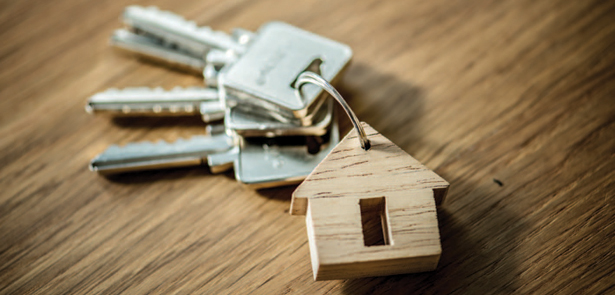Round the houses

The local property market offers excellent choice and outstanding value to potential buyers – a fact jealously coveted by towns just a few miles further south
After a relatively quiet winter and talk of ‘Brexit headwinds’ spring’s arrival greets the start of the traditional house-hunting season, with homes of all types and tenures coming onto the market. The Moment investigates the health of the Peterborough housing market, the key drivers behind it, and offers a few tips to make house buying a breeze.
The saying goes that an Englishman’s home is his castle. Judging by our obsession with TV property shows, DIY and the classic dinner party talk of house prices, there’s a lot of truth to that. Yet while the general trend for has always been up, even the Great British property market takes a breather from time to time. The last 12 months has been one of those periods, with a somewhat subdued housing market across the country, Peterborough proving no exception. Factors such as uncertain in the economy, the B-word (whisper it… ‘Brexit’) and last year’s interest rate rise have served as a drag on house prices. This isn’t necessarily bad news for those looking to sell their home – and it’s positively good news The last 12 months has been one of those periods, with a somewhat subdued housing market across the country, Peterborough proving no exception. Factors such as uncertain in the economy, the B-word (whisper it… ‘Brexit’) and last year’s interest rate rise have served as a drag on house prices. This isn’t necessarily bad news for those looking to sell their home – and it’s positively good news for those looking to buy as prices take a pause on their relentless climb.
Prices in Peterborough
So what’s going on in Peterborough itself ? Well, prices are up 3% on the previous year and 10% up on 2016. And while house price growth has slowed in recent months, growth in the city over the past year remains higher than the 2.5% rise nationally. Peterborough represents genuinely good value for money. Average house prices in the city stand at £196,000 versus a UK average of £231,000 – and that’s despite the fact you can get into central London in under an hour by train. On average a full-time employee in England and Wales can expect to pay 7.8 times of their gross annual earnings on an existing property. Zoom into Cambridge and this jumps to around 13.5 times, whereas here in Peterborough the average house price to earnings ratio is a far more comfortable 6.6. Still, like everywhere in the country, affordability has steadily declined; 20 years ago a home in the city would have cost just under three times your salary, though on the flip side interest rates were painfully higher. The average property price masks some significant variations by neighbourhood. In Orton Longueville an average home will set you back £256,000, while in Bretton you’ll pay a more modest £179,000.
Outside interest
Higher prices elsewhere have naturally created a lot of interest in Peterborough, which also enjoys a strong economy in its own right. Vernon Moore of local estate agent Moores Country & Commuting offers his take: ‘The city is a hugely attractive proposition to buyers further south. As you’d expect, there’s a very strong correlation between every minute sat on a train or mile driven up the A1 and the average house price. In fact, house prices drop by an average of £4,000 for every mile travelled, so you can see how Peterborough would look remarkable value to someone living in, say, Welwyn Garden City or Watford.’ Vernon cites advances in flexible and home working as key drivers in unlocking people from traditional commuter belts. ‘People can sell a three-bed semi close to the M25, move to Peterborough and find they can afford a four-bed detached property with money left over for private schooling or to pay down the mortgage.’
Vernon, who has just opened a branch next to Peterborough Station to cope with demand, actively markets the Peterborough properties on his books to buyers in Hertfordshire, Essex and London. ‘There are many more people moving up from these areas, looking for something a little bigger than they can’t afford down there.’ Vernon is seeing particularly strong interest for properties that are within easy reach of the train station. ‘Faster trains to London are tying in with the increase in hot desking in London. In contrast to the traditional first-thing commuter, more people are now travelling throughout the day. Many of our clients look to move out to the country but when they realise they can buy an attractive town house on the edge of Peterborough there’s a strong inclination to gravitate towards these properties because of their convenience for the station.’
Where next?
No-one can accurately predict future house prices. Indeed, if we had a penny for every time the experts weighed in with their opinions on the future direction of house prices we’d have enough for a pied-à-terre in Kensington and Chelsea (house price to earnings ratio of 41)! Nevertheless, it’s safe to assume that in the short term at least, continuing uncertainty coupled with the recent tightening on lending criteria will help to keep the brakes applied. In the medium term, though, the relative affordability of the city strongly suggests there is still room for growth. ‘I think we’re in a growth phase as more people move to Peterborough,’ adds Vernon. ‘But they come up for value.
One of the reasons Peterborough is so busy is that Cambridge is just too much. In Cambridge the price per square foot is now around £6-700. Compare that to, say, Stamford, a pretty Cambridge equivalent, where you can buy for £300-350 per square foot and get double the property. But, of course, if properties were to rise too high in this area then people seeking out value will look further north still – to Grantham or Newark. It’s the difference in house prices that is keeping the local market moving.’
Future supply
The recent publication of Savills’ Peterborough: A growing city report highlights that while the area is responding to strong demand for new housing through ambitious house-building targets and a healthy land supply, only exceptionally high levels of development will meet that demand. The new Local Plan targets more than 1,200 new homes a year, representing a housebuilding rate equivalent to 1.5% of the existing stock every year. James Abbott is head of residential sales at Savills Stamford: ‘The largest share of supply will be coming through on city fringe areas, with plans to build on the success of The Hamptons. 750 homes will be delivered at Hampton over the next five years, and consent has been granted for a 5,300 home scheme at Great Haddon. In the longer term, proposals include a 2,500 home new settlement at the former Peterborough aerodrome.’
Like Vernon, James is reasonably bullish about the medium-term prospects for the city. ‘House price growth in neighbouring markets and the wider county have shown signs of slowing in recent years, but Peterborough still has room to grow. The city itself has the most diverse residential market, with lower value areas to the east contrasting with pockets of high value areas towards the centre.’ David Goodson, who heads Savills’ Peterborough office, agrees: ‘As an affordable location and well-connected city, it is clear to see that Peterborough has huge potential for growth. With careful planning, the city will continue to thrive.’
Advice for buyers
Buying a house is the biggest purchase of your life. Get it right and you could save thousands. Chloe King, Sales Manager at Ashwood Homes, offers her key points every home buyer should consider.
● Mortgage: Make sure you seek out sound independent financial advice to secure the best mortgage deal, usually from a mortgage broker. This could save you thousands over the course of the mortgage term. Securing a ‘mortgage in principle’ and arranging proof of your deposit in advance of putting in an offer or reserving a new home can ensure your offer is taken far more seriously.
● Freehold or leasehold: Check whether a home is freehold or leasehold. Freehold means you will own both the property and the land outright. With a leasehold you will own the property but not the land, which you lease for a period of time from the freeholder. Most flats and maisonettes are leasehold, but so are some houses. Extending a lease can be costly, and if a lease has less than 70 years to run it can be difficult to secure a mortgage on.
● Stamp duty: Stamp duty is due on any property costing more than £125,000, unless you are a first-time buyer when there is zero stamp duty to pay on the first £300,000 of any home costing up to £500,000. Check online for stamp duty calculators. Stamp duty is usually paid on completion. Other costs to consider include mortgage arrangement and valuation fees, legal fees, surveys and, of course, moving costs.
● New homes: If you are looking to buy a new home consider a new build. You will receive a 10-year structural warranty as standard, so there’s additional peace of mind. Research housebuilders and customer testimonials before committing and visit plenty of developments to get a property that’s right for you.
● Selling a home: Finally, if you have a property to sell, be sure to choose the best and most proactive agent, not always the one that values it at the highest asking price! A realistic asking price will achieve a sale quicker, ensuring your house isn’t sitting on the market for months and going ‘stale’. You can check past sold prices on websites such as Rightmove, Zoopla and Nethouseprices.















